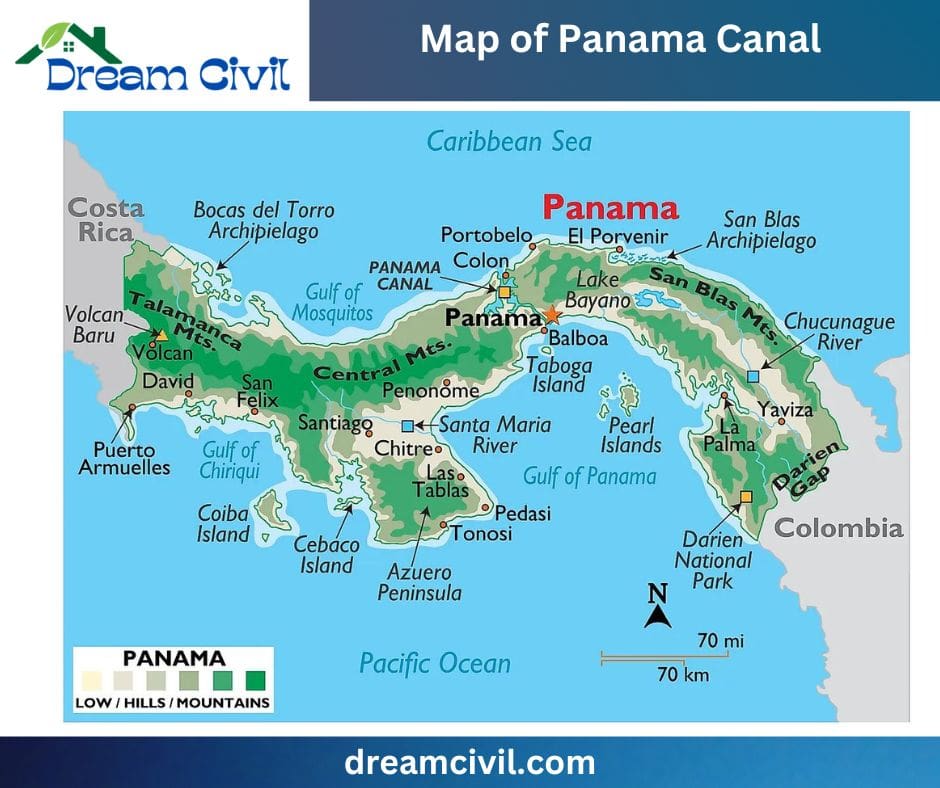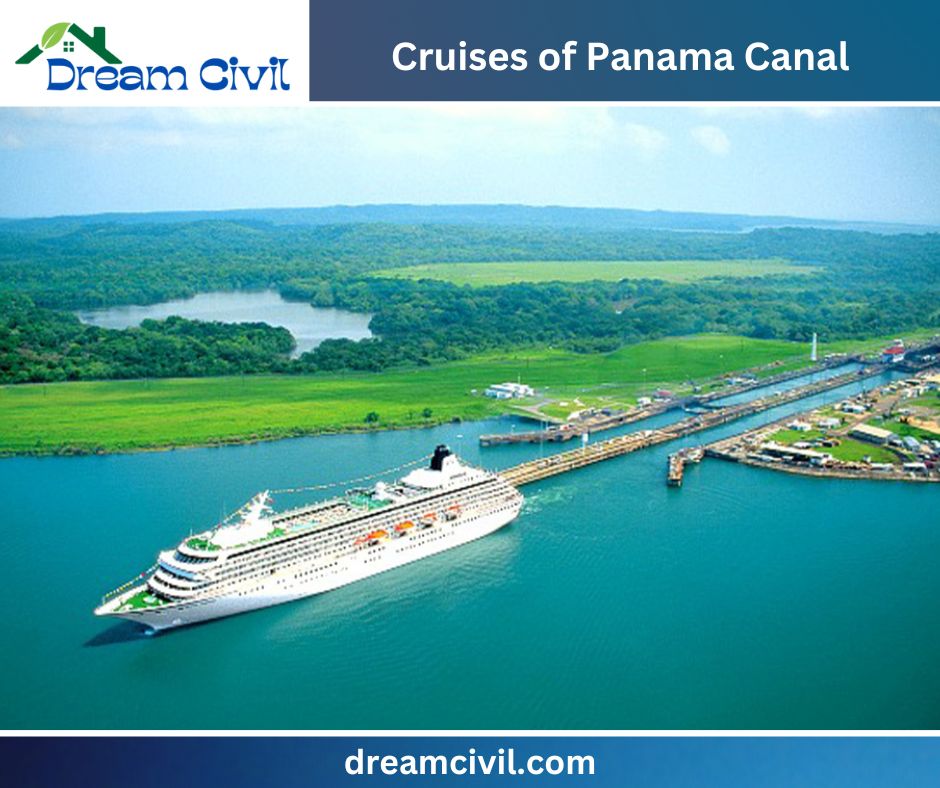Table of Contents
This article provides detailed information on the Panama Canal, including its map, history, cruises, and construction.
| Read More: 15 Most Effective Construction Safety Training For Homeowners |
A. Which country is the Panama Canal in?

✓ Panama is a Central American country located on the Isthmus of Panama, a narrow land bridge connecting North and South America.
✓ The tropical nation comprises the isthmus and more than 1,600 islands on its Atlantic and Pacific coasts.
✓ The country is renowned for the Panama Canal that crosses its midsection.
B. What is the Panama Canal famous for?

✓ The Panama Canal, considered one of the 7 Wonders of the Modern World, is a destination that travelers must visit while in the country.
✓ Its construction aimed to decrease the travel time of ships between the Pacific Ocean and the Caribbean Sea, resulting in numerous benefits.
✓ The canal has already served more than 900,000 vessels and still operates today.
C. What are the facts about the Panama Canal?

1. There exists a shortcut connecting the Atlantic and Pacific Oceans.
2. This shortcut has been in existence for over 100 years.
3. However, the construction of this shortcut came at a significant cost of over 25,000 lives.
4. Despite the cost, it is recognized as one of the Man-Made Wonders of the World.
5. Since its opening, more than 1 million vessels have taken advantage of this shortcut.
6. Annually, over $2 billion in tolls are collected from this shortcut.
D. Map of the Panama Canal:

✓ The Panama Canal is in Central America, specifically the Republic of Panama.
✓ This artificial canal stretches 82 kilometers (or 51 miles) and crosses the Isthmus of Panama, which separates North and South America.
✓ A map of the Panama Canal would typically display crucial features such as the Atlantic and Pacific Oceans, the Isthmus of Panama, the Gatun Locks, Pedro Miguel Locks, and Miraflores Locks, the artificial lake created by the Gatun Dam, the cities of Colon and Panama City, as well as shipping lanes and other landmarks of interest.
✓ The canal comprises various parts, such as the Atlantic entrance in Colon, where the channel passes through the Gatun Locks, raising ships to the level of Gatun Lake.
✓ This artificial lake is created by damming the Chagres River and is 26 meters (or 85 feet) above sea level, allowing ships to pass through the canal without requiring extra locks.
✓ The Pacific entrance is in Panama City, where the channel passes through the Pedro Miguel and Miraflores Locks, lowering ships to sea level.
✓ The Panama Canal is a crucial route for international commerce, saving ships thousands of miles by bypassing the Cape Horn at the southern tip of South America.
✓ Furthermore, it helps protect the environment by reducing air pollution and greenhouse gas emissions.
E. History of the Panama Canal:

✓ The history of the Panama Canal dates back to the 16th century when the idea of connecting the Atlantic and Pacific Oceans was first proposed.
✓ However, serious attempts to construct the canal were not made until the late 19th century.
✓ In 1881, Ferdinand de Lesseps led a French company in the canal’s construction, but the project faced numerous problems. It was ultimately abandoned in 1889 after the loss of over 20,000 workers.
✓ In 1903, the United States intervened in Panamanian politics and helped establish the Republic of Panama.
✓ The US then took over the canal construction, which was completed in 1914.
✓ The Panama Canal was a significant engineering feat and a symbol of American technological prowess.
✓ It revolutionized global trade, allowing ships to travel between the Atlantic and Pacific Oceans more efficiently and faster.
✓ The United States controlled the Panama Canal until 1979, when it was transferred to Panama and is now operated by the Panama Canal Authority.
✓ The canal is an essential shipping route for international commerce, saving ships thousands of miles by bypassing the Cape Horn at the southern tip of South America.
✓ It also helps reduce air pollution and greenhouse gas emissions, thus protecting the environment.
✓ The Panama Canal continues to be a marvel of engineering and a testament to the ingenuity and determination of the people who built it.
✓ It underwent expansion between 2007-2016 to accommodate larger ships. Today, it remains a source of pride for the Panamanian people and an integral part of the global economy.
F. Cruises of the Panama Canal:
✓ The Panama Canal is an 82-kilometer artificial waterway in Panama that connects the Atlantic and Pacific oceans, cutting across the Isthmus of Panama that separates North and South America.

✓ There are numerous cruise lines if you want to cruise through the Panama Canal.
✓ These cruises often depart from Miami or Los Angeles and travel to the Caribbean, Central America, or South American destinations.
✓ Your cruise ship will pass through the canal as part of the journey. For the best experience, it’s recommended to plan your trip during the dry season, which spans from December to April.
✓ The weather is usually sunny and clear during this time, and the canal is less crowded.
✓ Remember that the cost of a Panama Canal cruise can vary depending on factors such as the cruise line, duration of the trip, and time of year.
✓ Generally, you can expect to pay anywhere from a few thousand to several thousand dollars for a cruise.
G. Construction details of the Panama Canal:

✓ From 1904 to 1914, the United States accomplished the remarkable feat of constructing the Panama Canal.
✓ The project required the labor of more than 25,000 workers, many of whom lost their lives to diseases such as malaria and yellow fever.
✓ The construction involved dredging, blasting, and building locks, with the latter being the most notable feature of the canal.
✓ The locks enable ships to be lifted and lowered to move from one level to another. The Panama Canal is an engineering marvel and plays a crucial role in the global economy.
✓ It saves ships from traveling thousands of miles by avoiding the Cape Horn at the southern tip of South America.
✓ Moreover, the canal helps protect the environment by reducing air pollution and greenhouse gas emissions.
Here are some essential details about the construction of the Panama Canal:
1. The canal spans 82 kilometers (51 miles) in length.
2. There are three locks along the canal: Gatun Locks, Pedro Miguel Locks, and Miraflores Locks.
3. These locks raise and lower ships by 26 meters (85 feet).
4. The canal can accommodate vessels weighing up to 150,000 deadweight tons.
5. The average transit time through the canal is approximately 10 hours.
6. The construction of the Panama Canal cost $400 million (equivalent to $14.6 billion in 2022).

